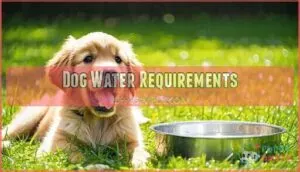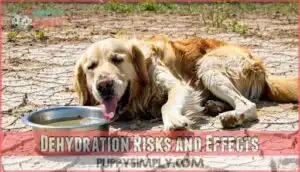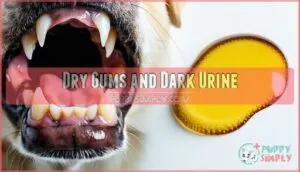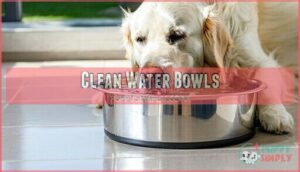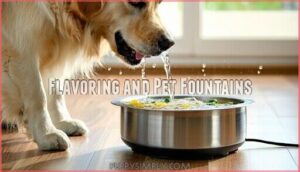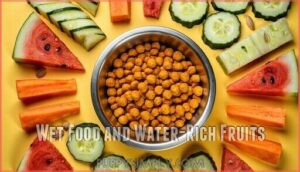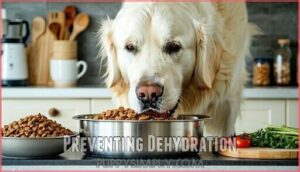This site is supported by our readers. We may earn a commission, at no cost to you, if you purchase through links.

Dehydration can kick in fast, especially if it’s hot or they’re active. You might notice dry gums, sunken eyes, or even sluggish behavior—clear signals they need water ASAP.
Staying hydrated is as essential for dogs as it is for us. Their bodies rely on water to keep organs working and temperatures regulated.
If your dog isn’t drinking or is showing signs of dehydration, it’s time to act quickly. Curious about how to keep their water intake steady and safe? There’s more to uncover, especially about the importance of staying hydrated.
Table Of Contents
- Key Takeaways
- Dog Water Requirements
- How Long Without Water
- Dehydration Risks and Effects
- Signs of Dehydration
- Encouraging Hydration
- Preventing Dehydration
- Survival Times and Veterinary Care
- Frequently Asked Questions (FAQs)
- How long is it safe for a dog to go without water?
- What are the best ways to encourage a dog to drink more water?
- Are there any alternatives to water for hydrating a dog?
- What are the long-term effects of dehydration in dogs?
- Is it safe to give a dog Gatorade or electrolyte solutions?
- Are there any special tips for keeping a puppy hydrated?
- Can dogs survive on snow as a water source?
- What are the best dog water dish materials?
- Do certain dog breeds require more water?
- How does diet affect daily water intake?
- Conclusion
Key Takeaways
- Your dog can survive about 2–3 days without water, but dehydration can start causing harm within 24 hours, leading to symptoms like lethargy and dry gums.
- Ensure your dog drinks around 1 ounce of water per pound of body weight daily, adjusting for factors like activity level, weather, and health.
- Look for signs of dehydration, such as sunken eyes, sticky gums, dark urine, or unusual lethargy, and act fast to prevent severe complications like organ damage.
- To keep your dog hydrated, provide clean water, use wet food, try water-rich treats like watermelon, and consider adding flavor or using a pet fountain.
Dog Water Requirements
Your dog needs about an ounce of water per pound of body weight every day to stay healthy.
Factors like age, weather, and activity level can affect how much water they’ll need.
Daily Water Needs
Dogs should drink about 1 ounce of water per pound of body weight daily.
Larger breeds need more due to size, while canned food can help with hydration.
Active dogs working up a sweat—or pant—may require extra water.
If your pup’s picky, try flavoring their water to keep dehydration far, far away.
Factors Affecting Water Needs
Your dog’s water needs depend on several factors.
Active pups need more hydration, while quieter dogs sip less. Hot weather and indoor heating play a big role. Health issues like kidney problems or pregnancy can increase thirst. Breed size also matters—bigger dogs, bigger gulps!
Keep an eye to avoid dog dehydration and meet their changing water intake needs:
- Activity Levels: Energetic dogs need more water.
- Health Status: Illness increases hydration demands.
- Diet Type: Wet food provides extra water; kibble doesn’t.
Environmental Temperature Impact
Hot days can amplify a dog’s water needs fast.
Humidity effects make panting less effective, increasing heatstroke risks.
Larger breeds or those with thick coats feel seasonal changes more severely. Activity levels spike dehydration chances too.
Keep fresh water handy, especially outdoors.
Environmental factors like warm temps directly impact dog water intake, showing how sensitive they’re to heat.
Health Conditions and Water Needs
When illnesses or medical conditions affect a dog’s body, their water needs can change.
Health issues like kidney disease, diabetes insipidus, or bladder infections can increase thirst, while medication effects and fever impact hydration too.
Anxiety may cause reluctance to drink, further complicating hydration.
Keep an eye out for:
- Lower-than-usual water intake
- Dog dehydration causes like illness or stress
- Signs of dog kidney failure
- Underlying health conditions reducing water needs
How Long Without Water
Water needs vary, but in the event of skipping hydration, things can get serious fast.
Healthy dogs might manage without water for about 3 days, though they’ll likely show dehydration symptoms much sooner.
After 24 hours, a dog not drinking water can start showing dog dehydration symptoms like lethargy or dry gums.
Beyond 2 days, risks increase substantially, leading to potential organ damage and long-term, irreversible effects.
Survival factors, like age, size, and health, play a big role in how long dogs can survive without water.
- A proper dehydration timeline shows risks escalating after just one day.
- Organ damage can occur when dehydration stresses bodily systems.
- Smaller or sick dogs face faster water deprivation consequences.
- Severe cases quickly require medical emergency intervention.
Dehydration Risks and Effects
Dehydration can hit your dog faster than you might think, causing serious health risks within just a day.
Without water, every system in their body starts to struggle, leading to symptoms like lethargy and, in severe cases, organ failure.
Dehydration Timeline
After about 24 hours without water, dehydration onset begins, and dog dehydration symptoms like dry gums and lethargy appear.
Dehydration kicks in within 24 hours—watch for dry gums and lethargy to safeguard your pup’s health and vitality.
Early signs of dehydration include dark urine and reduced skin elasticity.
By 72 hours, irreversible damage to organs may occur, reaching the survival limit.
Monitoring hydration is key to avoiding harmful 24-hour effects and dangerous complications like organ damage from dehydration symptoms, which can lead to severe dehydration symptoms.
Severe Dehydration Symptoms
After 24 hours without water, severe dehydration symptoms in dogs quickly show.
Pay attention to:
- Sunken eyes and sticky, dry gums.
- Lethargy severity grows, making them act sluggish.
- Vomiting/diarrhea, worsening their state.
These signs scream "medical emergency." Organ damage could start setting in, so you’ll need veterinary care fast.
If your dog shows these dehydration symptoms, don’t wait—hydration and swift treatment are critical to their recovery.
Organ Failure and Fatalities
Lack of water hits hard. Dehydration complications escalate quickly, leading to kidney failure and organ damage. Fatal dehydration occurs when essential systems shut down, making this a real medical emergency.
Imagine a machine running without oil; that’s your dog without water.
| Stage | Effect on Body | Warning Signs | Severity | Outcome |
|---|---|---|---|---|
| 12–24 hours | Dehydration begins | Lethargy, dry gums | Moderate | Reversible |
| 24–48 hours | Kidney strain starts | Dark urine, vomiting | Critical | Treatable early |
| 48–72 hours | Severe organ damage | Extreme lethargy | Life-threatening | Irreversible |
| Over 72 hours | System failure | Sunken eyes, coma | Fatal | Recovery unlikely |
| Untreated Weeks | Chronic organ damage develops | Weakness, organ shut down | Severe | Death |
Don’t wait—hydration isn’t optional! Dehydration can lead to severe organ damage, and in extreme cases, system failure. It is crucial to address dehydration promptly to prevent irreversible damage and ensure a reversible outcome. Fatal dehydration is a serious concern, and critical action is necessary to prevent it.
Chronic Dehydration Strain
Over time, dehydration puts strain on every part of your dog’s body, leading to organ damage and systemic effects.
Chronic dehydration risks include kidney failure and irreversible organ failure.
Look for subtle indicators that something’s wrong:
- Reduced energy and dull coat
- Digestive issues from long-term impact
- Recurring dehydration complications
Preventative measures, like constant access to water, help avoid these dehydration risks.
Signs of Dehydration
When your dog isn’t drinking enough water, their body shows clear signs that you shouldn’t ignore.
Symptoms like dry gums, sunken eyes, or sluggish behavior mean it’s time to act fast.
Loss of Skin Elasticity
To check for canine dehydration, try the skin elasticity test.
Gently pinch the skin between your dog’s shoulders, then release it.
If the skin tents or takes a while to return to place, dehydration risks might be present.
Factors like age and hydration impact turgor pressure, making this a key dehydration assessment.
Always monitor dehydration signs carefully.
Dry Gums and Dark Urine
Another sign you’ll notice is dry gums. Healthy gums should be wet and smooth, so sticky or dry gums signal dehydration.
Urine color also helps gauge hydration—dark yellow or concentrated urine often points to dehydration severity.
Regular hydration monitoring matters. If these signs pop up, don’t wait; a veterinary assessment guarantees your dog’s health and survival without water stays on track.
Lethargy and Sunken Eyes
When dogs face severe dehydration, lethargy and sunken eyes are two major red flags.
Lethargy and sunken eyes signal severe dehydration—act fast to restore hydration and save your dog’s health.
Lethargy causes them to seem unusually tired or disinterested in activities, while their eyes may appear dull or deeply set.
These signs show dehydration severity and require immediate veterinary assessment.
Early symptom progression can lead to organ issues, as dogs can’t survive long without water.
Behavioral Changes and Irritability
When hydration drops, strange dog behavior changes might surface.
Dehydration aggression or irritability can appear due to thirst frustration and water avoidance.
Behavioral indicators like snapping, restlessness, or unexplained pacing might surprise you.
Irritability causes in dogs often stem from physical discomfort during dog water deprivation.
Addressing this irritability may require understanding underlying fear or anxiety.
If you spot these signs of dehydration, dogs need prompt water access to guarantee survival without worsening health risks, which can be a matter of life and require urgent action.
Encouraging Hydration
Keeping your dog hydrated doesn’t have to be tricky if you know a few simple tips.
Clean water bowls, tasty flavor options, and adding water-rich foods can make drinking more appealing.
Clean Water Bowls
Keeping your dog’s water bowl clean is key to avoiding bacteria buildup and ensuring their water stays fresh.
Use safe bowl materials like stainless steel or ceramic, as plastic can retain odors. Consider a durable steel option for its longevity and hygiene.
Clean dog water bowls daily to maintain water quality. Place the bowl near their regular spots for easy water access and to support their dog water needs effectively, ensuring fresh water is always available.
Flavoring and Pet Fountains
A fresh water source is key, but pet fountains can make drinking irresistible by boosting water palatability through constant flow.
You could try flavored water, like adding a splash of chicken broth, to meet dog water needs.
Remember that lack of physical activity can reduce water intake.
Fountain types vary, so choose what works best, and don’t forget fountain maintenance—dirty water isn’t appealing to anyone, including your pup, which affects the overall water intake.
Wet Food and Water-Rich Fruits
Adding variety can boost your pup’s water intake.
Wet food benefits include higher dietary moisture, making meals both tasty and hydrating. Water-rich foods like cucumbers or watermelon are also great for dog hydration.
Consider various palatable options for your dog. Need ideas? Try these:
- Cucumber: Crunchy, low-calorie, and hydrating.
- Watermelon: Sweet and packed with water (remove seeds!).
- Carrot slices: Palatable water sources packed with nutrients.
Electrolyte Solutions and Ice Cubes
Electrolyte solutions and ice cubes can boost hydration in dehydrated dogs.
Electrolyte benefits include faster recovery and balancing lost minerals, while ice cubes keep water intake fun and gradual.
Use homemade solutions or low-sodium options.
Always monitor for ice cube safety to avoid choking.
| Solution | Usage Tips | Safety Notes |
|---|---|---|
| Electrolytes | Mix into water gently | Avoid high salt levels |
| Ice Cubes | Use small, rounded pieces | Supervise while eating |
| Homemade Mixes | Include chicken broth flavor | Consult a vet first |
The table provides usage tips and safety notes for different solutions, including Electrolytes, Ice Cubes, and Homemade Mixes.
It is essential to follow these guidelines to ensure the safe and effective use of these solutions.
Preventing Dehydration
You can prevent dehydration in your dog by keeping fresh water available at all times and monitoring how much they drink.
Carry water on walks, especially in hot weather, and watch for signs they’re thirsty or overheated.
Carrying Water on Walks
Portable water keeps your dog hydrated during walks, especially in summer.
Dog water bottles are a lifesaver for meeting hydration needs.
Avoid unsafe water sources; they can carry bacteria.
For long or hot walks, prioritize water intake to prevent overheating.
Plan breaks, carry dog-specific bottles, and make certain regular sips to quench dog thirst and maintain hydration easily.
Many owners find portable dog bottles essential for their pets, as it helps in keeping them hydrated.
Monitoring Water Intake
Keep track of your dog’s water intake frequency by measuring how much they drink daily.
Place their water bowl in a familiar, accessible spot to encourage hydrating.
Watch for behavioral cues like excessive panting or lethargy—these are signs of dehydration in dogs.
Use hydration apps to monitor water intake and guarantee it aligns with dog water requirements to prevent dehydration issues.
Providing Access to Fresh Water
Fresh water access is essential for a dog’s hydration.
Make it easier with these strategies:
- Place bowls in various spots so water’s always within reach.
- Use automatic dispensers to keep water fresh and inviting.
- Opt for filtered water to remove impurities.
- Verify water isn’t too hot or cold—room temperature works best.
These simple tweaks can improve your dog’s water intake effortlessly.
Remember that cooler weather reduces thirst is a key factor to consider for your dog’s water intake, and ensuring access to fresh water is crucial for their overall health.
Avoiding Overhydration
Too much water can harm dogs, leading to water intoxication and electrolyte imbalance.
Watch activity levels and adjust hydration strategies to fit individual needs.
Monitor kidney function and urine color for hints of overhydration.
If unsure, consult a vet for guidance.
Always offer water in smaller amounts after intense play to avoid health risks, as balance is key!
Survival Times and Veterinary Care
A healthy dog can survive about three days without water, but dehydration starts causing harm much sooner.
Knowing the signs of dehydration and acting quickly with veterinary care can save your dog’s life.
Average Survival Time Without Water
A dog’s survival without water typically ranges from 48 to 72 hours.
Dehydration in dogs begins within 24 hours, causing serious issues if left unchecked.
Dog survival without water varies by age, health, and activity levels. Puppies and senior dogs dehydrate faster.
Always monitor hydration to avoid reaching canine survival limits. Fresh water daily is essential!
Factors Affecting Survival Time
Dog survival time without water isn’t one-size-fits-all.
Size matters—smaller dogs dehydrate faster due to higher metabolism. Age influences too, as puppies and senior dogs struggle more.
Health status plays a role; illnesses like kidney disease reduce a dog’s ability to stay hydrated.
Activity levels and breed differences also affect how long dogs survive without water, so always monitor their needs.
Seeking Immediate Veterinary Care
If you notice emergency signs like dry gums, sunken eyes, or lethargy, seek veterinary intervention right away.
Diagnostic tests help identify causes like dehydration or organ failure. Don’t wait—it’s a true dog emergency.
Vets offer treatment options like fluids or medications to prevent coma. Quick action improves prognosis factors and eases pet suffering while safeguarding long-term health, which is crucial for preventing a coma.
Treatment and Recovery From Dehydration
Rehydrating a dehydrated dog requires careful steps to restore health. Start with small amounts of water or electrolyte solutions. Severe cases need veterinary intervention for fluid administration and organ support.
For a prompt recovery:
- Use intravenous fluids for serious dehydration.
- Gradually reintroduce a post-dehydration diet with monitoring recovery.
- Keep electrolyte balance steady with prescribed treatments.
Act fast for your pup’s health!
Frequently Asked Questions (FAQs)
How long is it safe for a dog to go without water?
Imagine hiking with your pup and forgetting water—trouble starts fast.
A healthy dog shouldn’t go more than 24 hours without water.
Beyond that, dehydration risks like lethargy and organ damage rise sharply.
Always prioritize hydration.
What are the best ways to encourage a dog to drink more water?
Offer fresh water in a clean bowl, add low-salt chicken broth for flavor, or use a pet fountain.
Try ice cubes as treats, mix water with wet food, and make certain easy access.
Are there any alternatives to water for hydrating a dog?
You can try low-sodium chicken broth, water-rich fruits like watermelon or cucumber, or even ice cubes.
Adding flavor to water or using dog-safe electrolyte solutions works too.
Always check with your vet first!
What are the long-term effects of dehydration in dogs?
Dehydration hits dogs like a slow-burning fire—it damages organs, weakens muscles, and strains the heart.
Long-term effects include kidney failure, chronic health issues, and reduced immune strength, leaving your dog vulnerable to infections and other complications, ultimately leading to chronic health issues.
Is it safe to give a dog Gatorade or electrolyte solutions?
You can give your dog Gatorade or electrolyte solutions in small amounts, but stick to dog-specific options when possible.
Human products can have too much sugar or additives that aren’t ideal for dogs.
Always consult your vet to ensure the best decision for your dog’s health, and remember to choose dog-specific options whenever possible.
Are there any special tips for keeping a puppy hydrated?
Keep your puppy’s water bowl clean and filled with fresh water.
Use shallow bowls to make drinking easier.
Add water to their food, offer ice cubes, or try flavored options like low-sodium chicken broth.
Stay observant!
Can dogs survive on snow as a water source?
Relying on snow for water is like drinking from a cracked cup—it’s unreliable.
Snow’s water content is low, and dogs risk dehydration or hypothermia.
Always provide clean, liquid water, no matter the season, as clean, liquid water is essential for their health.
What are the best dog water dish materials?
Stainless steel bowls are your best bet—durable, easy to clean, and bacteria-resistant.
Ceramic dishes work too but can chip.
Avoid plastic; it scratches easily, trapping bacteria.
Choose a weighted design to prevent spills or tipping.
Do certain dog breeds require more water?
Some breeds, like larger or more active ones, need more water due to size and energy levels.
Breeds with thick coats or high-energy dogs might drink more, especially in warm weather or after exercise.
How does diet affect daily water intake?
Your dog’s diet plays a big role in water needs.
Wet food provides extra hydration, while dry kibble doesn’t.
If they eat dry food, they’ll need more water to stay properly hydrated and healthy.
Conclusion
A dog’s body is about 60% water, underscoring how important hydration is for their survival.
While dogs can technically go 2–3 days without water, it’s dangerous and can lead to severe dehydration, organ failure, or worse.
Recognize signs like dry gums, sunken eyes, and sluggish behavior.
Always provide fresh water, monitor their intake, and act fast if issues arise, knowing that severe dehydration can have serious consequences.
Knowing how long a dog can go without water helps you keep them safe and healthy every day.

